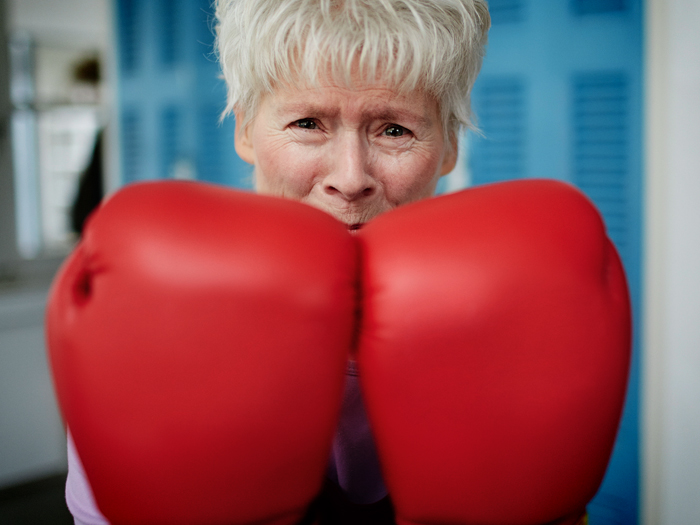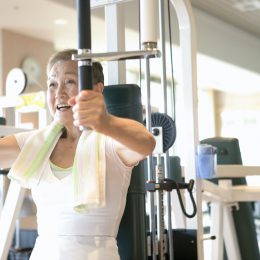5 Reasons You Need to Try Fitness Boxing
Throwing punches is a fun way to stay strong and fit at any age, but it may be especially beneficial for older adults. Here’s why.

Boxing has come a long way since Rocky Balboa entered the ring. The newest trend in the sport, called fitness boxing, involves throwing punches at a bag or in the air for a fun mind-body workout—without risk of head trauma.
“Boxing workouts are a combination of bodyweight exercises, speed training, and muscle memory that require you to think quickly about your next move,” says Steve Halloran, a co-founder of RockBox Fitness. “Unlike other forms of exercising that isolate specific parts of the body, boxing engages the entire body, focusing on muscle movement and memory.”
Classes usually involve following an instructor through a series of boxing moves choreographed to upbeat music, similar to your favorite aerobics class. You’ll do sweeping punches (crosses, hooks, and uppercuts); smaller punches (jabs); squats (ducks); and short, quick steps forward and back.
It’s a fantastic way to stay fit at any age, but it may be especially beneficial as you get older. Here’s why.
Reason #1: You’ll Improve Hand-Eye Coordination
As you age, your fine motor skills decline. That means your hands may not be able to perform tasks with the same accuracy and speed as when you were younger. This happens due to age-related changes in the structure, function, and biochemistry of the brain, according to a review of recent studies.
Aerobic exercise of any kind is associated with improvement in certain brain functions, but boxing in particular is known for improving hand-eye coordination, Halloran says.
That’s because sparring on a bag, hitting boxing pads, or just shadowboxing with an imaginary opponent all involve reaching out to targets in space, which research shows improves hand-eye coordination and possibly makes you feel more alert.
How that can help in real life: Better hand-eye coordination makes it easier to respond to information from the world around us, whether it’s picking up a pen you dropped on the floor or tracking a tennis ball as it comes over the net.
Want to check how well your eyes and hands are working together right now? Try this quick hand-eye coordination challenge.
Reason #2: You May Sharpen Your Brain
Boxing workouts are a go-to tool for Joe Perron, director of CRV Therapeutic Recreation Services in New Hampshire. In his 30 years of working with adults with dementia and Parkinson’s disease, Perron has seen the power of regular shadowboxing sessions to help improve cognitive abilities and alertness.
Science supports his observation. A 2014 study of older adults with mild cognitive impairment found those who spent 30 minutes jogging and 60 minutes shadowboxing once per week for six months improved cognitive function, including their immediate memory and recall abilities, compared with those who didn’t exercise.
While aerobic exercise in general has a neuroprotective effect that may help prevent age-related cognitive decline, boxing may impart bonus benefits by constantly requiring you to think.
“In boxing, there are four basic punches to remember—jab, cross, hook, and uppercut—and they can be worked into different combinations,” Halloran explains. “Not only do you memorize the proper form of each move, but you anticipate your [imaginary] opponent’s next movement and how to counter.”
To carry out each combination, your brain always stays one step (or punch) ahead of your body.
Reason #3: You’ll Build Total-Body Strength
Boxing may seem like it’s all about the arms and shoulders, but it only takes trying it once to know your entire body is working.
“Effectively throwing punches starts at the feet,” Halloran says. “Power is driven through the lower body, up through the core, and then extends out of the arms.”
For starters, standing in the boxer crouch with knees slightly bent strengthens your lower body. Plus, you may need to bob and weave to evade make-believe punches from your competitor. That translates into performing dozens of squats during your workout.
The result: You’ll build stronger feet, ankles, knees, hips, and glutes for a more stable foundation. A stronger lower body makes it easier to stand, walk, and climb stairs on your own power—and helps prevent falls.
Reason #4: You Can Go at Your Own Pace
You are completely in control of the speed and intensity of your practice when boxing, Halloran says. This allows you to push yourself as hard as you want without risking overdoing it.
Subscribe to our newsletter
It's quick and easy. You could be one of the 13 million people who are eligible.
Already a member? Click to discover our 15,000+ participating locations.
Follow Us
Plus, both shadowboxing and heavy-bag workouts can be completed from a seated position, Perron adds. So whatever your current fitness level or health status, boxing can work for you.
Instead of getting caught up in how hard you’re punching, Halloran recommends focusing on the quality of each movement. You’ll allow for better form and help yourself tune in to exactly how much you’ve progressed from workout to workout, he says.
Reason #5: It’s Great for Exercisers with Joint or Bone Issues
If you need to avoid weight-bearing, high-impact exercise due to arthritis or osteoporosis, don’t write off boxing. It can be an excellent low- or no-impact workout, depending on your needs.
“Shadowboxing—or punching the air—is the best practice for individuals with osteoarthritis or osteoporosis, as it eliminates the force and impact against the body you would normally feel when colliding with the bag or pads,” Halloran says.
Meanwhile, by standing and throwing punches, you’re still loading your legs, hips, and lower spine with your bodyweight. This helps strengthen the muscles that surround your body’s joints, while also working directly on the bones to slow mineral loss.
If you don’t have the strength to stand and do boxing moves, you’ll still get an effective workout punching the air while seated. Just make sure your upper-body movements are big enough to get your heart pumping.
As always, if you’re starting a new fitness routine, managing a chronic condition, or recovering from an injury, it’s smart to talk to your doctor about how to exercise safely.
Check Your SilverSneakers Eligibility Instantly
SilverSneakers members can go to thousands of gyms and fitness locations across the nation, plus take exercise classes designed for seniors and led by supportive instructors. If you have a Medicare Plan, it may include SilverSneakers—at no additional cost. Check your eligibility instantly here.
Already a member? Get your SilverSneakers member ID and exclusive fitness content by logging in to or creating your online account here.





